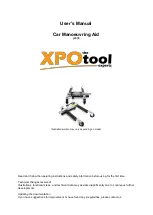
700-1000 - B
June - 2010
13
BATTERY CHARGING
Connect the charging unit to the port located on the contact side of the battery. It is not necessary to fully
discharge the battery prior to charging. Battery should be charged daily and cannot be overcharged. It
takes two to four hours to fully charge depending upon battery usage. Do not allow battery to fully
discharge, as it will shorten battery life. Whenever battery is removed from Control Box or lift is not in use
it is important to connect battery to charger. This ensures battery is fully charged and ready for use.
A fully charged battery will provide approximately 30 lifting cycles, depending on the weight of the users.
The battery is fully charged prior to shipping, but should be checked by observing the LCD indicator,
located on the Control Box, prior to use to ensure sufficient charge level.
Do not drop the battery, as it could cause the unit to fail. If the battery case is cracked do not use and
replace. Do not place battery on a conductive surface. Placing battery on a conductive surface may cause
a short. Battery has contacts located on bottom of housing. During temperature extremes beyond the
range of
41 F (5 C)
to 104 F (40 C) remove battery and place in a controlled environment or battery life
can be shortened.
Keep the Console/Battery Cover installed at all times to prevent moisture from collecting on the Control
Box and battery. Excessive moisture collection can affect battery and lift performance and could lead to
battery failure and/or the lift failing to operate.
IN CASE OF BATTERY FAILURE
Turning failure -
If the lift will not turn electronically, you can remove the housing and loosen the nut
(7/16” – 11mm) on the tension spring located next to the turning motor. This will disengage the gears and
allow the lift to be turned manually.
If the PAL will be used by a disabled person living on their own, a communication device should
be installed in the area of use to call for assistance in the event of an emergency.
BATTERY DISPOSAL
The battery is recyclable and shall be disposed of in accordance with applicable local, state/provincial or
federal/national regulations.






































